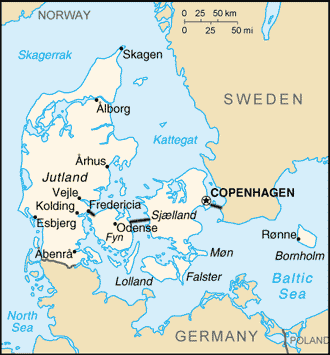Basic Geography of Denmark Posted by Bjørn A. Bojesen on Nov 18, 2011 in Uncategorized
Denmark seen from foreign land
looks but like a grain of sand
famously wrote Danish poet Piet Hein (1905-1996), before admitting
Denmark as we Danes conceive it
is so big you won’t believe it!
True enough, area-wise Danmark ranks among the world’s smaller countries, with just 43 thousand square kilometres of dry land (about 16 thousand square miles, or a bit larger than Maryland and Delaware combined). If you casually glance at a globe, you’ll probably hardly notice Denmark – a tiny appendix between Tyskland (Germany) and the Scandinavian peninsula of Norge (Norway) and Sverige (Sweden). Yet Denmark is very much a ”world within the world”, with hundreds of islands, rural landscapes, industrial areas, beaches, forests, vibrant cities and isolated villages.
Basically, the country consists of one continental part, Jylland, and øerne – the islands – of which Fyn and Sjælland (where the capital is located) are the most notable. And even Jylland, which shares a border with Germany in the South, is called a halvø, literally ’half-island’ (that is, peninsula). So Denmark is very much an island nation…
Let’s take a look at some of its main parts:
Jylland, in English Jutland. This is Denmark’s geographical link to the European continent. It covers 2/3 of the country’s area, but has only got the lesser half of its inhabitants. People here are called jyder (Jutes), and live in cities like Aalborg, Esbjerg, Vejle and Århus (also written Aarhus).
Fyn, in English Funen. The central major island, connected to Jutland and Zealand with broer (bridges). The inhabitants are called fynboer, and the main city is Odense. Just for the sake of it – let’s also mention Svendborg.
Sjælland, in English Zealand. This is Denmark’s hub, mostly because of the capital København (Copenhagen), which is found on the island’s eastern shore and is the home of more than 1 million københavnere (Copenhageners). There are, however, also other important cities, such as Roskilde and Helsingør (Elsinore). People here are called sjællændere (zealanders). For some reason their island is sometimes (jokingly) referred to as ”Djævleøen” – the Devil Island.
Lolland-Falster. These are actually two islands, linked to each other and South Zealand by bridges. The inhabitants are called lollændere/lollikker (singular lollik) and falstringer, respectively.
Bornholm. Denmark’s easternmost outlier, closer to Sweden than Zealand. The main city or town is Rønne, and the island is inhabited by bornholmere (bornholmers).

Build vocabulary, practice pronunciation, and more with Transparent Language Online. Available anytime, anywhere, on any device.
About the Author: Bjørn A. Bojesen
I was born in Denmark, but spent large parts of my childhood and study years in Norway. I later returned to Denmark, where I finished my MA in Scandinavian Studies. Having relatives in Sweden as well, I feel very Scandinavian! I enjoy reading and travelling, and sharing stories with you! You’re always welcome to share your thoughts with me and the other readers.




